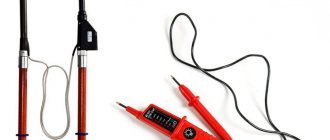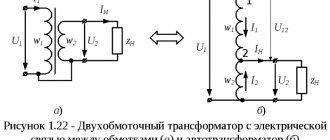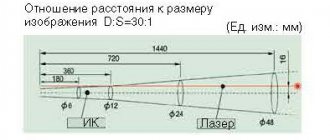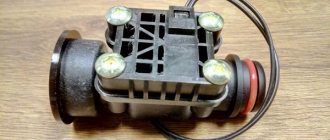One of the varieties of pyrometers - thermometers designed for non-contact measurements of the surface temperature of the body under study without the use of additional equipment - is an optical pyrometer (or a visual pyrometer with a disappearing filament).
Instruments of this class of measuring instruments work on a visual comparison of the intensity of monochromatic radiation, which almost any object possesses, and the intensity of a pyrometric incandescent lamp taken as the standard. Optical pyrometers are widely used for temperature measurements in the visible region of the spectrum and find their application:
- in heavy and metallurgical industries;
- in electrical equipment diagnostic services and automotive service centers;
- during transportation and storage of food products and medicines;
- in scientific and laboratory research for practical thermometry;
- in general construction and specialized engineering processes.
One of the main advantages of using optical pyrometers: the absence of influence of the measuring instrument on the temperature field of the radiation object, since during the diagnostics performed their direct contact with each other is not provided.
Application area
Pyrometers have found quite wide application in those industries where a large number of heating devices are installed. In the field of construction and thermal power engineering, they are used to calculate the heat loss of structures, including a pyrometer that helps to identify damage to thermal insulation.
In industry, such devices make it possible to analyze the temperature of various processes remotely. This is necessary, for example, in mechanical engineering, metallurgy and other industries.
Thus, electricians check the heating level of wire connections, and car mechanics check the heating of car parts. Pyrometers come to the aid of scientists during various studies or experiments: this is how they determine the accuracy of the temperature of substances and bodies.
In everyday life, people use such devices to determine body temperature, water, food, etc.
Rating of laser non-contact pyrometers 2022
To understand which pyrometer is best to buy for your home, you should read the review of popular models. The most popular among buyers are non-contact devices with a laser sight.
ADA TemPro 700 A00224
A relatively inexpensive device from the professional category is suitable for detecting heat leaks in the house. Supplied in a durable case with a long handle, it is resistant to temperature changes and is characterized by highly reliable results. Equipped with a laser sight that allows you to take pinpoint readings.
Pyrometer ADA TemPro 700 can be purchased for 3,500 rubles
Testo 830-T1
The device is suitable for measuring low and high temperatures, and works not only with solid objects, but also with liquids. Thanks to the built-in laser, it can take readings from both large areas and small areas. Capable of taking measurements in the range from - 30 to + 400 °C.
Price Testo 830-T1 starts from 4000 rubles
Bosch PTD 1
The universal device determines the air and surface temperature, as well as the humidity level in the room. Used for technical purposes, helps identify heat leaks. Takes measurements from -20 to 200 °C on the surface, and as a room thermometer displays readings from -10 to 40 °C.
Reliable Bosch PTD 1 costs an average of 8,000 rubles
Stationary modification
These models differ significantly in layout and represent a cylindrical optical module, inside of which a measuring sensor is enclosed. This component is connected by a special durable cable to an electronic control module, which is equipped with a monochrome liquid crystal display and a push-button control menu.
The unit is placed in a closed panel, power and signal lines are connected. Subsequently, the value of the output current (or voltage) is transmitted via wires to the computer using special logic tools (controllers) and specialized software. This scheme is more convenient, since the screen of the electronic module is small. It is difficult to distinguish the displayed readings.
Stationary pyrometers are suitable for use in various industries. They are manufactured with a wide range of measurable limits. Thanks to this quality, the device allows you to control any technological process related to temperature.
Top 3 best pyrometers from AliExpress
Cheap but functional pyrometers can be purchased online through AliExpress. Although the reliability of such devices is considered lower than that of devices from branded stores, they usually cope well with everyday tasks.
Habotest HT650A
A convenient home pyrometer with a circular sight is suitable for determining not only temperature, but also humidity. The maximum threshold for the device is 380 °C; the infrared device operates on a non-contact principle.
The cost of Habotest is from 1400 rubles on AliExpress
Norm 400/600
The infrared device is capable of measuring temperatures up to 400 °C, suitable for any purpose - from medical to household. Despite its low cost, it has a small error of about 1.5%.
The cost of the Norm 400/600 pyrometer is about 4000 rubles
DT-8809C
A mid-budget device from AliExpress measures the temperature of a person up to 43 °C and of inanimate objects - up to 100 °C. It is highly accurate, easy to use, and measurements can be taken from a distance of 5-10 cm.
You can buy DT-8809C from 4000 rubles
What does a pyrometer measure?
The subject of the definition is the average temperature value for the surfaces of objects and bodies within the measurement spots. They have an ellipsoid or round shape. The longer the path from the measurement object to the pyrometer, the larger the size of the spot. The device is aimed at the desired object or material using a laser pointer built into it. It is directed directly to the center of the circle being measured.
Modern pyrometers record temperature remotely, allow minimal errors, and also have an ergonomic design and autonomous power supply. This equipment is used when necessary:
- control the temperature conditions of objects in conditions of high risk of electric shock;
- deal with the surface of objects where sudden temperature changes may be observed;
- measure the heating force of objects with unusual temperature conditions (high levels on one element and normal values on another element).
Since the device has a special operating principle based on “reading” the radiation of thermal waves in the infrared range, it is capable of recording temperature indicators of objects that are located at a distance of up to 15 meters. Thanks to this, the device has the following advantages:
- safety;
- ease of use;
- high accuracy of recording parameters of bodies, objects, structures, materials.
Design features and basics of use
The key elements of any non-contact thermometer are:
- a telescope-converter, in the focal plane of which an image of the object being examined is created; At the same focal level there is a tungsten lamp filament. Two diaphragms ensure constancy and extreme input and output angular parameters of the telescopic system, and a glass red light filter monochromatizes the visual beam observed by the operator.
- measuring device: in stationary instruments for general industrial use, an indicating millivoltmeter or milliammeter with a graduated reading scale serves as this. In exemplary pyrometric models of increased accuracy, the measuring device is a potentiometer, which guarantees a minimum measurement error.
- power source (rechargeable cell or battery).
The reliability of operation of non-contact optical thermometers is determined by the stability of the parameters of the reference lamp and the accuracy of the readings of the measuring device.
The filament's heat depends on the strength of the electric current flowing through it, which is controlled by a rheostat. The observer through the eyepiece of the telescope sees the thread and the image of the radiation object combined with it. The current is adjusted by a rheostat until the visual brightness of the reference thread is the same as the brightness of the body image: at which point the thread superimposed on the image disappears.
The lower limit of measurement depends on the human eye and is limited by the brightness indicator, which is too weak for observation; the upper limit is the limit of the brightness value acceptable for the eye (approximately 1200-1300 ° C).
How to use?
The manual device is easy to operate. The rules for taking measurements are simple and are as follows:
1. The pyrometer must be turned on;
2. Using a laser pointer, point it at the object to be measured;
3. Press the activation button (trigger).
After completing these steps, the temperature value will be displayed on the screen. An important condition for successful and accurate measurement is compliance with the size of the sighting spot on the surface. If you do not adhere to the recommendation, then this means an unacceptable error.
Due to their operating and installation features, stationary models of pyrometers only need to be configured once.
Which pyrometer is better - laser or infrared?
Pyrometers come in optical and infrared types. It is the latter that are usually used in everyday life; they are compact, have good accuracy and display the results in digital form.
As for laser devices, they are a type of infrared. We are talking about devices equipped with an aiming system. They are more convenient to use than devices that do not have a laser sight. The simplest models of pyrometers measure temperature “over an area” and do not focus on a specific point on an object. Laser-based devices evaluate infrared radiation over a selected small area and therefore exhibit increased accuracy.
Pyrometers with a laser sight are objectively better; they guarantee high measurement accuracy
Types of pyrometers
All pyrometers can be divided into the following categories or characteristics: by measurement principle, by temperature range and by method of operation.
According to the measurement principle, pyrometers are:
- brightness pyrometers that allow you to determine the temperature of an object by comparing the color with a standard.
- Radiation pyrometers that measure the temperature of an object by recalculating the power of thermal radiation.
- Color pyrometers allow you to draw conclusions about the temperature of an object based on the results of comparing its thermal radiation in different spectra.
By temperature range:
- Low temperature. Pyrometers of this type are capable of determining negative temperatures, while the range of positive temperatures can be quite large.
- High temperature. Pyrometers operate in a high temperature range and are not capable of measuring objects with negative temperatures.
By method of operation:
- Portable pyrometers are designed for use in field conditions. They are light in weight, display indicators, and are self-powered. Designed for a very wide range of temperature measurement applications. They can have internal memory and connect to a computer to transfer data.
- Stationary pyrometers are designed to perform mostly permanent measurements at a specific point. They have increased accuracy and, as a rule, do not have their own display, but transmit data to a computer or control panel. They are able to work under unfavorable environmental conditions. Most often they are used when measurements are required at industrial enterprises. They are large in size and weight.
Two main pyrometry methods
Practical pyrometry arose at the turn of the 19th and 20th centuries. Around the same time, two main methods of pyrometry were formed: radiation (brightness) pyrometry and color pyrometry. These names have changed and adjusted over time, but the essence of the methods has remained unchanged. The brightness pyrometry method (also called radiation pyrometry, radiation pyrometry) uses the dependence of the energy brightness of an object’s radiation in a limited range of wavelengths on its temperature. In other words, the brightness of an object's radiation depends on its temperature. Consequently, by measuring the brightness of an object's radiation, we can measure (with varying accuracy) the temperature of the object. Thus, the key element of a radiation pyrometer is a radiation receiver, which converts the radiation energy arriving at it into another physical quantity, most often into current or voltage. It is complemented by an optical system that collects radiation from an object at a certain solid angle, and an electronic circuit with power supply and display systems that amplify, convert and display the measurement result. The method of color optical pyrometry was initially based on the dependence of the spectral distribution of the radiation flux of a heated object on temperature in the range of visible wavelengths. In other words, the color of its radiation depended on the temperature of the heated object. Objects heated to 700–800°C glow with dark orange light; at 1000–1200°C the color of the glow becomes bright orange, gradually turning yellow; at 2000°C the color is perceived by our eyes as bright yellow, and after 2500 °C the glow approaches white. For a long time, the main elements of color comparison were the operator's eye and a heated filament (or coil) located in the eyepiece of the pyrometer in the operator's field of view. The thread in the eyepiece was aligned with the image of the object being measured. By adjusting the electric current passing through the filament, the operator selected its value so that the color of the filament coincided with the color of the object being measured. At a certain current value, the image of the filament “disappeared” against the background of the heated object, which was a criterion for the equality of the temperature of the object and the heated filament. By the way, this is where the common name in the literature for such pyrometers comes from – vanishing filament pyrometers. Due to the characteristics of human vision, the described method, while relying on the perception of color by the human eye, has serious limitations in the accuracy and repeatability of measurement results. Therefore, with the development of the component base, very subjective visual measurements were replaced by measurements using several radiation receivers operating in different spectral ranges. There can be three or seven such receivers, but in practice they are most often limited to two. Thus, at present this method is based on the temperature dependence of the ratio of the energetic brightness of an object in two different regions of the emission spectrum. Accordingly, this method is called the spectral ratio pyrometry method. (Source: PHOTONICS 4/2009)
Specifications
The pyrometer has a number of parameters that characterize its functionality. The choice of the desired device model is carried out according to their values. Let's look at the main ones.
Optical resolution
This is the name given to the ratio of the diameter of the tool spot to the distance to the object. This function depends on the angle of the device’s lens: the larger it is, the larger the area it can cover. The most important factor in the accuracy of the measurement is the application of the spot exclusively to the surface material. If the area is exceeded, the measured value will likely be inaccurate.
REFERENCE. Each pyrometer model has a different optical resolution. The difference between them is impressive, for example, from 2:1 to 600:1. The last ratio is typical for professional devices. As a rule, they are used in heavy industry. The optimal ratio for household and semi-professional pyrometers is 10:1.
Operating range
The operating range of the device depends on the pyrometric sensor and often varies from -30 °C to 360 °C. Thus, almost all types of pyrometers are suitable for domestic use, if we take into account the maximum temperature of the coolant in the heating system up to 110 °C.
Spectral range of the pyrometer. Effective wavelength
In practice, most radiation receivers have a significantly wide wavelength range, and even the use of filters does not sufficiently limit the wavelength range to be considered strictly monochromatic. However, the energy versus wavelength curve is very steep at short wavelengths, and the pyrometer readings are in clear agreement over a significant temperature range with Planck calculations corresponding to a wavelength close to the “cutoff” upper wavelength of the receiver-filter system. The concept of effective wavelength is very convenient for estimating the rate of change in energy (and therefore pyrometer readings) with temperature, as well as the error arising from an error in determining the surface emissivity. IEC 62942 defines the spectral range and effective wavelength of a pyrometer as follows: 4.1.1.9 Spectral range The spectral range is given in µm or nm. The spectral range is defined as the lower and upper limit of the wavelength when the spectral sensitivity reaches 50% of the peak sensitivity. The fundamental (effective) wavelength and the full bandwidth at which sensitivity reaches 50% of peak sensitivity (full width at half maximum (FWHM)) may also be given. It is common practice to give the effective spectral wavelength and full width at half maximum (FWHM) for monochromatic pyrometers, and to give upper and lower limits for broadband pyrometers. Here is a table from IEC 62942 (Appendix 1) demonstrating the change in pyrometer readings corresponding to a 1% change in received radiation at a reference pyrometer temperature of 23 °C
The change in the indicated temperature corresponding to the change in the radiation flux received by the pyrometer was calculated as:
The following table shows the uncertainty due to a 10% change in emissivity at 500°C.
From the above data it follows that you should always select a pyrometer with the shortest wavelength that allows you to make the necessary measurements of the lowest temperature in the measuring range. In addition to the difficulty of taking into account the emissivity of the object, furious pyrometers have a number of other significant disadvantages; their results depend on: the distance to the measured object, the shape of the object, dust and gas contamination of the intermediate medium, the presence of protective glasses and opaque objects in the field of view of the pyrometer, side illumination when working with large-sized objects, re-reflections by the measured object of radiation from highly heated objects located nearby. As you can see, there are about a dozen factors that prevent radiation pyrometers from obtaining accurate results. This is why users are increasingly thinking about using spectral ratio pyrometers, which are more expensive than radiation ones, but free from many of the above disadvantages.
Operating principle
The operation of devices of this type is based on the occurrence of infrared radiation and determining the absolute value of the wavelength energy emitted in the infrared spectrum.
The instrument is directed to a distant object, the distance to which is limited only by the diameter of the spot being measured and the composition (“purity”) of the air environment surrounding the object. Measuring the characteristics of an object's radiation (its intensity and spectral composition) with a pyrometric device indirectly determines the temperature of its surface.
The operating principle of the pyrometer determines the main functionality of the instrument:
- measuring the temperature of remote (inaccessible or difficult to reach) objects, as well as the temperature of their moving elements;
- analysis of the temperature regime of energized objects when contact measurement methods are not possible;
- express recording of rapid temperature changes on the surface of an object body;
- study of objects with low heat capacity or thermal conductivity.
Using a pyrometer at industrial facilities and in everyday life does not present any difficulties: the instrument is aimed at the object being examined, temperature data is measured and recorded on the display in a matter of seconds by pressing and holding the trigger.
Introduction
Radiation thermometers (or pyrometers) are non-contact temperature sensors, the action of which is based on the dependence of temperature on the amount of thermal electromagnetic radiation received from the measurement object. This is a whole group of devices, which includes both devices that measure the temperature of a point on an object, a region on an object, or that allows one to obtain a picture of a one-dimensional and even two-dimensional temperature distribution over a given measurement area. Radiation thermometers are very widely used in various industries: metallurgy, glass and ceramics, semiconductors, plastics, paper, etc. Radiation thermometers are also used in medicine, forensics, human rescue and security systems. The main difficulty is measuring the temperature of a body whose emissivity is unknown. The object of measurement is most often far from a completely black body; it can be an oxidized surface, translucent glass, a mirror surface, etc. In addition, difficulties arise in accounting for radiation emitted by a nearby area and radiation reflected from neighboring objects. Unfortunately, there is no single optical pyrometry method that can cover the full range of situations encountered. However, various approaches have been developed, each of which is able to overcome one or two of the above-mentioned difficulties. Instruments of this type have many names: optical pyrometers, radiation pyrometers, total radiation pyrometers, automatic infrared thermometers, continuous radiation thermometers, line scanners, thermal imaging radiometers, surface pyrometers, ratio pyrometers, two-color pyrometers, etc. These names are more related to the purpose of the devices. A general term that applies to this class of devices and has a technical functional meaning is radiation thermometers. Recently, interest has increased in the formation of an international universal terminology in non-contact thermometry and the development of a nomenclature of international requirements for the characteristics of radiation thermometers. Thus, in 2006-2007, a new IEC standard “Technical requirements for radiation thermometers” was developed. (IEC TS 62492 Radiation thermometers - Part 1: Specifications for Radiation Thermometers). The new standard was put into circulation in March 2008. For information on the participation of Russian specialists in the development of IEC standards, see. RGE section. A detailed analysis of terminology in the field of pyrometry and trends in the development of terms is given in the article published on the website by the director of TECHNO-AS LLC S.S. Sergeev “Trends in changes in terminology in pyrometry.” We invite you to discuss basic terms in the forum section “Terms and definitions in the field of thermometry”. Radiation thermometers are evolving instruments, with many reports at international conferences and many publications in journals devoted to improving non-contact methods of temperature measurement and increasing their accuracy. We hope that on our website you will be able to read articles about new products in this area in the sections “publications”, “manufacturers of non-contact temperature sensors”, “device catalog”.
What additional functions are there?
Depending on the scope of application of the pyrometer, the feasibility of purchasing is determined: a simple model or with a set of additional properties. In any case, they are worth mentioning:
- Display backlight (Bosch PTD 1 0603683020, ADA TemPro 1600 A00128). Almost all devices have this function and it is justified. Even during operation in poor visibility, the data is clearly visible.
- Built-in memory (ADA TemPro 1600 A00128). Depending on the equipment model, you can save up to 10 measurements. This is very convenient because the information does not need to be written down in a notepad.
- Connection to a computer via USB port. The readings can be saved on a computer for later use in job analysis or reporting.
- Determination of the maximum/minimum value, calculation of the difference between readings, average temperature (ADA TemPro 1600 A00128). These functions are useful if you plan to perform complex diagnostics of the mechanism.
- Holding the received reading on the screen (Testo 830-T3). It is convenient to work with such a device, because after a measurement is taken, the readings will not disappear, but will be visible until the person activates another program.
These parameters must be taken into account when choosing, because with them you can perform even very complex measurements simply, quickly and with pleasure. Detailed information about the characteristics and capabilities of the device is indicated in the product instructions, so be sure to read it before purchasing. Knowing all the most important features of different models of equipment, it will be easy for you to choose the most suitable one.
Don't doubt that using the tool in practice will not be difficult, and imagine the costs that can be avoided by having such an assistant. With a pyrometer, you will be able to promptly detect a “weak” spot in a car engine, in a home boiler room or on the roof. Thus, there is no need to buy a new “engine” (quite expensive), the boiler will not fail because the hose will be changed in time, the wallpaper on the wall of the room will not need to be re-glued due to humidity. Do any of these reasons sound familiar? Then don’t hesitate to place your order through the online store “”! After completing the payment procedure, the purchase will be delivered as soon as possible and you will immediately be able to begin the planned temperature diagnosis.
Emissivity (emissivity)
Emissivity (sometimes called “blackness”) describes the ability of a body surface to emit infrared energy. This coefficient is defined as the ratio of the energy emitted by a particular surface at a certain temperature to the energy emitted by a black body at the same temperature. (see also section GLOSSARY OF TERMS). It can take values from very small, below 0.1 to close to 1. IR thermometers, as a rule, make it possible to set its own emissivity for each object. Incorrect choice of emissivity is the main source of error for all pyrometric temperature measurement methods. How to choose the degree of blackness? There are reference tables showing the degree of emissivity for various materials and various surface treatments. Tables for some common materials are provided in the “Reference” section of the site. It should be noted that the emissivity is strongly influenced by the oxidation of the metal surface. So, if for oxidized steel the coefficient is approximately 0.85, then for polished steel it decreases to 0.075. Experimental techniques can also be used. The most common methods for calibrating pyrometers and thermal imaging thermometers are the following methods for determining emissivity. 1. Determine the actual temperature of the object using a contact sensor - thermocouple, resistance thermometer, etc. Then measure the temperature using a pyrometer and select a degree of blackness such that the pyrometer readings coincide with the readings of the contact sensor. 2. At relatively low temperatures of the object (up to 250°C), you can stick black tape (for example, electrical insulating tape) to a section of the surface of the object. Then measure the temperature of the tape using a pyrometer with the emissivity set to 0.95. After this, use a pyrometer to measure the part of the object not covered by the tape and select a degree of blackness such that the pyrometer readings coincide with the result of the tape measurement. 3. If part of the object can be painted, paint it with matte black paint, which has a blackness level of about 0.98. Then measure the temperature of the painted area using a pyrometer with the emissivity set at 0.98. After this, measure the unpainted part of the object using a pyrometer and select such a degree of blackness that the pyrometer readings coincide with the measurement result on the painted area. (source: verification method for IR pyrometers "Thermoscope-100" LLC "Infratest"). . It should be noted that the emissivity depends on the wavelength. The shorter the wavelength, the higher it is. In addition, the error caused by an inaccurate determination of the emissivity will be proportional to the effective wavelength. In cases where, for example, it is necessary to measure the surface temperature of a partially oxidized metal, the advantage of short-wave pyrometers is obvious, because the oxidized layer will have a high and stable emissivity at short wavelengths rather than at long ones. In addition, short-wave brightness pyrometers are generally less affected by atmospheric absorption than broad-spectrum pyrometers. If absorption is caused by particles or droplets in the sighting path, the reduced error value at short wavelengths will have a lower relative energy dependence of temperature measurements. Therefore, where high accuracy of surface temperature measurement is required, it is recommended to use a short-wave brightness pyrometer. The name “short-wave” is relative, for example at T=1000°C 1 µm is a short wavelength; while at T=10°C 10 µm is also considered a short length. The effective wavelength criterion for classifying a pyrometer as sufficiently “short-wavelength” is the maximum wavelength, which must be so short as to provide sufficient energy to obtain the required signal-to-noise ratio from the detector at the minimum measured temperature. When performing theoretical analysis of effective wavelength, it is usually assumed that pyrometers use a narrow range of waves and therefore the change in readings depending on changes in temperature can be determined by Planck's law. where I(ν)dν is the radiation power per unit area of the radiating surface in the frequency range from ν to ν + dν. this expression is equivalent to the following: where u(l)dl is the radiation power per unit area of the emitting surface in the wavelength range from l to l + dl










